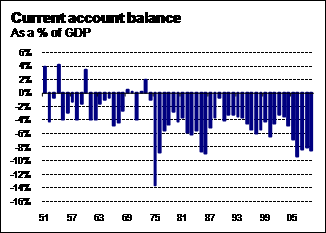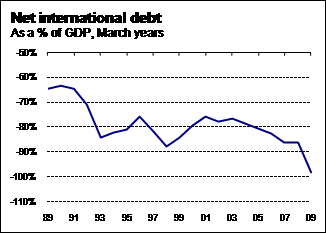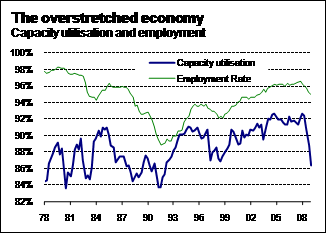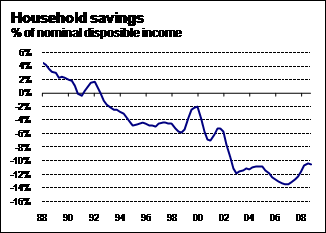The great correction
Recessions are obviously difficult times for both businesses and households, with uncertainty and pessimism dominating investment and spending decisions. However, recessions do have some positive outcomes, rectifying imbalances in the economy and cleaning out inefficient or poor business practices. The current recession, for example, has the potential to restore some balance to New Zealand’s external accounts and level of indebtedness.
| Economic imbalances | ||||||||||||
| 88-91 | 97-99 | Sep-09 | ||||||||||
| Pre-recession | Post-recession | Pre-recession | Post-recession | Pre-recession | Post-recession | |||||||
| Goods balance | 1.4% | Jun-90 | 5.1% | Jun-92 | 0.6% | Jun-97 | 1.7% | Sep-98 | -2.6% | Mar-06 | 1.0% | Sep-10 |
| Services Balance | -2.3% | Dec-92 | -0.1% | Mar-96 | -1.4% | Sep-98 | 1.5% | Jun-03 | -0.7% | Mar-09 | 1.0% | Dec-11 |
| Invisibles balance | -5.1% | Mar-88 | -3.3% | Mar-91 | -7.2% | Sep-97 | -4.1% | Jun-99 | -7.3% | Jun-08 | -4.8% | Dec-09 |
| BOP | -4.1% | Jun-90 | -2.7% | Jun-92 | -6.7% | Jun-97 | -3.9% | Jun-99 | -9.2% | Jun-06 | -4.8% | Jun-10 |
| Private Investment (% of GDP) | 16.0% | Dec-89 | 13.0% | Dec-91 | 19.3% | Sep-96 | 16.9% | Jun-99 | 21.3% | Jun-08 | 15.2% | Sep-10 |
| Household consumption growth | 2.6% | Jun-89 | -1.5% | Mar-92 | 6.2% | Mar-95 | 2.1% | Jun-98 | 4.1% | Dec-07 | -0.6% | Jun-09 |
| Household savings rate | -0.4% | Mar-91 | 1.7% | Mar-92 | -5.8% | Dec-98 | -2.1% | Mar-00 | -13.5% | Mar-07 | -4.2% | Dec-11 |
| Unemployment | 4.1% | Mar-87 | 11.2% | Sep-91 | 6.1% | Jun-96 | 7.9% | Dec-98 | 3.5% | Dec-07 | 6.9% | Dec-10 |
| Exchange Rate, TWI | 66.5 | Mar-88 | 53.5 | Sep-92 | 68.4 | Mar-97 | 47.8 | Dec-00 | 72.0 | Jun-07 | 53.7 | Mar-09 |
| Capacity Utilisation | 87.6% | Dec-89 | 83.7% | Sep-91 | 90.7% | Mar-97 | 86.9% | Sep-98 | 92.6% | Mar-08 | No forecast | |
| ANZ world commodity prices | 129.3 | Jun-89 | 105.0 | Dec-90 | 134.9 | Jun-95 | 104.6 | Jun-99 | 219.0 | Jun-08 | No forecast | |
A striking factor of this recession is the magnitude of our current account deficit at its onset. In June 2006, the deficit reached a staggering 9.2% of GDP, the worst since 1975. The deficit is large by international standards, but we will see a correction in the current account during this recession. There are two components that will drive this correction – the return of a trade surplus and a reduction of dividend and interest payments going offshore.

Import outlook worse than exports
A trade surplus should prevail by early 2010. New Zealand’s exports are dominated by agricultural and food commodities, in contrast to exports from nations such as Japan, which are dominated by manufactured products. In the current recession, New Zealand has an advantage in the sense that non-luxury items dominate our exports, so volumes haven’t taken as big a blow as those in many other economies. As the global recovery takes hold, this fact also suggests that demand for our exports will increase before demand for manufactured goods, and consequently our terms of trade should improve as our export prices rebound – there is already evidence of this lift in prices occurring.
However, it is a bleak forecast for imports, rather than an optimistic outlook for exports, that will be the primary driver of the correction in the trade balance. Over the March 2009 quarter import volumes plummeted 15% from a year earlier. And domestic demand looks set to stay low well into 2010.
Achieving a sustained correction in the trade balance is far from plain sailing though. The recent strength in the exchange rate makes an export-led recovery much more challenging. Also, the export base was arguably much broader back in the early 1990s recession than it is now. For example, in 1990 dairy production made up 14% of total goods exports, compared to 22% in 2008. New Zealand has a growing reliance on Fonterra’s performance – yet the latest forecast dairy pay-out is about 10% below the long-term average (after adjusting for inflation).
The other constraint tied in with having a high proportion of exports being agriculturally based is that there is limited capacity for growth. Due to the stock cycle, the extent to which the agricultural sector can raise its volume of production is limited.
Not so invisible
Our net liabilities to the world have now ballooned to 98% of GDP. The financial crisis has resulted in a much more conservative attitude towards risk, and so greater attention will be paid to New Zealand’s substantial debt. Investors will become more reluctant to fund our current account deficit, and there will be growing pressure to start reducing our foreign debt. In the short term, the thinning of profit margins (reducing the dividends leaving our shores), as well as a lower interest rate bill, will result in a large improvement in the balance of payments deficit.

An interesting point to note here is that with our net liabilities being so high, one might expect a much greater correction of the invisibles balance than in prior recessions. However, the make-up of the invisibles balance means that we do not expect it to improve by as much as it did following the Asian crisis in the late 1990s. In 1997, 36% of gross debt was made up of equity investment, but now it is only 19% of the debt. The return on debt (i.e. interest rates) is likely to be much less variable than returns on equity, and with equity now making up a much smaller proportion of total liabilities, the scope for investment payments heading offshore to ease is much reduced.
Bursting the investment bubble
New Zealand’s large current account deficit is symptomatic of economic activity that is being excessively driven by domestic demand. Although households have attracted a lot of attention for the strength of consumption spending growth over much of this decade, spending on gross fixed capital formation (i.e. spending on investment goods such as buildings, machinery, etc) has arguably been at higher and less sustainable levels.
The credit crisis and massive loss of confidence were always going to have a significant negative effect on business investment. With business profitability also being squeezed, investment spending is suffering and will continue to contract over the next 12 months. As a percentage of GDP, we expect private investment to ease by a total of six percentage points between 2008 and 2010. This reduction is twice as much as the one that occurred in either the 1990 recession or the Asian crisis of the late 1990s.
The overstretched economy
Even with private investment running at over 20% of GDP in March 2008, the New Zealand economy was showing signs of being overstretched. The capacity utilisation rate, as measured in the NZIER’s Quarterly Survey of Business Opinion, was as high as 92.6%. The unemployment rate had also fallen to 3.5%, its lowest level since the early 1980s.

With activity in the manufacturing and building sectors falling away, capacity utilisation dipped to a 17-year low of 86.3% earlier this year. The unemployment rate has also risen, but had only reached 5% by March this year – 15 months into the recession. Unemployment will continue to rise over the next year, reaching a peak of 6.9% in December 2010. In comparison to the early 1990s (when unemployment reached 11.2% at its peak), the labour market is showing greater signs of resilience. The restructuring taking place in the economy during the current recession is much less dramatic and widespread than it was during the late 1980s and early 1990s, so the number of job losses will be smaller. Firms are also trying to hold on to their workers as much as possible given the extreme tightness of the labour market and difficulties in getting new staff over the last few years.
What savings?
New Zealand’s household savings rate had deteriorated to-13.5% of nominal disposable income by early 2007. This figure was an all-time low, but households’ high debt levels and lack of savings are being exposed, to some extent, by the current recession.

It has been a common characteristic of previous recessions for the household savings rate to deteriorate during the early days of the recession before it improves. This lag is due to the initial dominating effect of increased unemployment and, thus, the loss of income faced by households. We expect this lagged effect to apply in the current recession as well, with some deterioration in the household savings rate over 2009 as unemployment continues to rise. But over 2010 and 2011, as the labour market stabilises and then starts to recover, there will be a long-overdue improvement in the household savings rate. We forecast that the household savings rate will reach -4.2% by the end of 2011, an improvement of nine percentage points. This improvement far surpasses the 3.5 percentage point lift in the savings rate in the late 1990s, and highlights how bad the household savings rate had become leading into the recession, and the massive scope for improvement that existed.
Recessions have the ability to highlight imbalances in any economy. For New Zealand, with several facets of our economy being pushed to their outer limits earlier this decade, this recession was destined to provoke large corrections in the economy. The massive current account deficit, horrific household saving rate, and an overstretched labour market are all undergoing some form of correction.
Given the persistently high exchange rate and relatively narrow export base, questions remain about whether some of the correction staking place in the economy will be large enough. With the starting point form any of these variables much more off-balance than heading into previous recessions, the corrections need to be that much greater as well. As noted in our recent forecasts, we have our doubts about whether the New Zealand economy’s problems will be adequately addressed over the next 12 months. On that basis, our forecasts highlight the chance of New Zealand’s creditworthiness being downgraded by international investors within the next five years. The negative credit watch announced this week by Fitch Ratings shows that we are not the only ones concerned about New Zealand’s imbalances.




